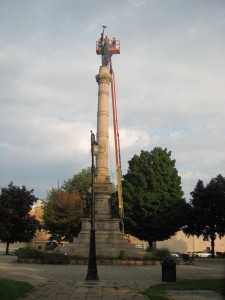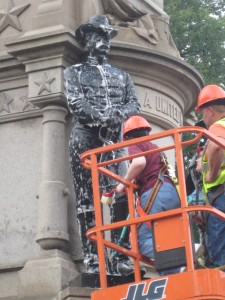
Hackley Park is an important focal point for downtown Muskegon Michigan. The park was dedicated on Memorial Day, May 30, 1892 . Charles H. Hackley, a prominent local lumber mill owner, purchased the land and paid for a Soldiers and Sailors Monument to commemorate the service of Muskegon County citizens during the American Civil War (1861-1865). The 76 foot tall granite monument includes five bronze statues and was designed by Italian-born architect Joseph Carabelli. Around the base are a sailor, cavalryman, infantryman and artilleryman. On the top of the pedestal stands a 14 foot goddess of Victory figure. The monument bears the inscription: “Not conquest, but peace – To the soldiers and sailors who fought and to all patriotic men and women who helped to preserve our nation in the war of the rebellion.”Four more statues were commissioned by Charles H. Hackley and installed on the four corners of Hackley Park on Memorial Day, 1900. They are sculptures of prominent Civil War persons. President Abraham Lincoln, Admiral Farragut were made by sculptor Charles Niehaus. General U.S. Grant and General William T. Sherman were made by J. Massey Rhind.

In 1997 -1998 the statues were conserved by McKay Lodge Fine Arts Conservation of Oberlin, Ohio. The Lakeshore Museum Center teamed with the City of Muskegon to develop a simple maintenance plan to help preserve the restored statues. Part of that teamwork is that our curatorial staff (meaning me, the Curator of Collections, and other curatorial staff as they are available) works with the City to give the statues a wash and a light coat of wax each year. We schedule this in early September of each year. It is usually mild weather with favorable relative humidity and temperature conditions. If it is too hot the wax does not set up, but if it is too cold the washing step is very uncomfortable and the wax is difficult to apply evenly.The wash removes surface grime and gives us a chance to inspect the statues for damage or deterioration. We use a mild detergent recommended by the conservator and fairly soft scrub brushes. The light coat of wax provides a thin layer of protection against the grime and makes it easier to remove it next year. We don’t attempt any more aggressive measures, since we are not metal conservators. It takes about 4 hours per statue depending on the conditions. A warm day with a slight breeze helps the statues to dry quickly. Wasp nests hidden in the folds of the sculpture is a very unpleasant surprise. I have angered a number of very large spiders as well with a soapy bath.
To access the statues, the City of Muskegon provides a tall lift – we have to get 80 feet into the air to reach the tip-top of Victory. This takes a skilled operator and nerves of steel. It can get pretty windy that high in the air – especially if there is a storm coming in across Lake Michigan. Maneuvering around the statues and the granite base also takes skill. We need to get close enough to work effectively, but not bang into the statues with the lift bucket. The bucket sways quite a bit – by the end of the week I resemble a tipsy sailor as the world sways no matter if I am on the lift or not. But the views of Muskegon Lake, the city and Lake Michigan are spectacular!
Text and pictures: Sharon McCullar
Hi Sharon – What a great story! Interesting about finding the perfect weather condition for the wax to dry. I’ve spent lots of time on (scissor) lifts – from cleaning ceilings to hanging sculptures – they take a bit of getting used to, and your article described the experience well.
Thank you for sharing!
______________________________
Español:
Hola Sharon – ¡Qué gran relato! Es interesante eso de encontrar las condiciones climáticas perfectas para que la cera se seque. Yo he pasado mucho tiempo montada en elevadores de tijera – desde limpiando techos hasta colgando esculturas – toma algo de tiempo acostumbrarse, y tu artículo ha descrito esa experiencia muy bien.
______________________________
Deutsch:
Hallo Sharon – Was für eine tolle Geschichte! Interessant, das über die perfekten Wetterbedingungen zu lesen, bei denen das Wachs trocknet. Ich habe viel Zeit auf (Scheren-)Hubsteigern verbracht – vom Reinigen von Decken bis zum Aufhängen von Skulpturen – man braucht ein bißchen, bis man sich dran gewöhnt hat und Dein Artikel beschreibt das ziemlich gut.
Danke fürs Teilen!
Annabelle,
Yes, the lift experience is definitely something to test one’s mettle. My colleagues will tell you that Dr Pepper and cookies are required supplies for statue cleaning week. I find that the wax goes onto the metal surface well when the day is sunny and has just a bit of a breeze. Temp between 70-75 is just great. Those conditions allow the wax to brush on smoothly, set up in a few minutes and buff to a nice shine with a soft rag. Any warmer and the wax doesn’t set up well to buff – stays too soft. Cooler or cloudy conditions makes it difficult to get the metal dry especially in the folds and shaded areas. The wax goes on rough and usually too thick. I will be the first to admit that the end result varies each time as I am no conservator, but I usually can get the surface washed and waxed well enough to cover and provide a measure of protection from dirt accumulation in the coming year. I try to coordinate with the City for the first week of September here in Michigan. Most years I have had good luck with the weather.
Hope that helps!
Sharon McCullar
______________________________
Español:
Annabelle, Sí, la experiencia sobre el ascensor es definitivamente algo para probar el valor de uno. Mis colegas te dirán que (una bebida como) el Dr. Pepper y unas galletas son los suministros requeridos para esa semana de limpieza de estatuas. Digo que la cera va bien sobre la superficie del metal cuando el día está soleado y con algo de brisa. Una temperatura entre 70-75 (°F) es perfecta. Esas condiciones permiten aplicar la cera suavemente y a los pocos minutos pulirla con un trapo suave, quedando con un bonito brillo. Una temperatura más cálida impide que la cera se aplique bien, pues queda demasiado blanda. En cambio, unas condiciones más frías y de mucha nubosidad dificultan que el metal esté seco, especialmente en los pliegues y las zonas sombreadas, y la cera queda áspera y demasiado gruesa. Yo soy la primera en admitir que el resultado final varía; no soy conservadora, pero por lo general consigo que la superficie esté lavada y encerada lo suficientemente bien como para cubrirla y proporcionarle una medida de protección contra la acumulación de suciedad para todo el siguiente año. Trataré de coordinarme con (las autoridades de) la Ciudad acá en Michigan, para la primera semana de Septiembre. En casi todos los años anteriores he sido afortunada con el clima. ¡Y espero que me siga ayudando!
Sharon McCullar
______________________________
Deutsch:
Annabelle, ja, das Hubsteiger-Erlebnis it wirklich etwas, mit dem man seine Standhaftigkeit unter Beweis stellen kann. Meine Kolleginnen und Kolleginnen können Dir versichern, dass Dr Pepper und Keks zur notwendigen Grundausstattung für die Woche des Statuenreinigens gehören. Ich habe herausgefunden, dass das Wachs am besten auf der Metalloberfläche haftet, wenn es ein sonniger Tag ist und es ein kleines bißchen Wind hat. Wenn die Temperatur zwischen 70 und 75 liegt (Fahrenheit, entspricht zwischen 21 und 24 Grad Celcius, Anmerkung der Übersetzerin) ist es am besten. Bei diesen Verhältnissen lässt sich das Wachs gut mit dem Pinsel verarbeiten, legt sich gut an und erhält mit einem weichen Tuch einen wunderbaren Glanz. Wenn es wärmer ist, trocknet das Wachs nicht gut genug und bekommt keinen schönen Glanz – bleibt zu weich. Wenn es kälter und bewölkt ist, wird es schwierig, das Metall trocken zu bekommen, besonders in den Falten und da, wo es schattig ist. Das wachs trocknet ungleichmäßig an und wird generell zu dick. Ich bin die erste, die zugibt, dass das Ergebnis von Mal zu Mal variiert und dass ich kein Restaurator bin. Aber wir bringen es normalerweise fertig, dass die Oberfläche gut genug gereinigt und gewachst ist, dass die Schutzschicht ein ausreichendes Maß an Schutz gegen die Verschmutzungen im Jahresverlauf bietet. Ich versuche immer, dass wir hier in Michigan mit der Stadt einen Termin in der ersten Septemberwoche hinbekommen. In den meisten Jahren hatten wir dann Glück mit dem Wetter.
Ich hoffe, das hilft weiter!
Sharon McCullar